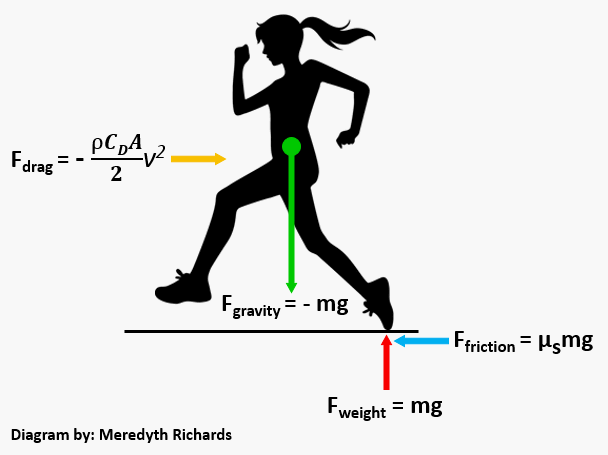| Main | The Equinox: Race & Course |
Physics
for Runners 101 |
Rooty Trails |
Killer Hills |
Downhill Dash |
Flat to the Finish |
How to Run the Equinox |
Sources & Further Reading |

| As bodies in motion, runners experience a variety
of forces opposing their movement. For forward
propulsion, runners must continuously supply forces
that are greater in magnitude and opposite in
direction to the physical (and mental) forces nudging
them to return to watching TV on the couch. The primary forces working on the average recreational runner* on a straight, flat surface are shown in the free-body diagram to the right. For forward movement, a runner must apply a force on the ground that exceeds the sum of Fgravity and Fdrag. (It's a bit counter-intuitive, but Ffriction helps propel the runner. More on that later.) Whether sufficient force is exerted depends upon the runner's fitness as well as on external factors such as wind, the texture of the terrain, and the position of the runner's center of mass relative to the ground. Due to the wide variability of these conditions in the Equinox, the forces encountered by its runners are also highly variable. Use the tabs above to explore how the forces change! |

|
| |
| Quick
Word About Friction While a detailed comparison of the frictional forces across the four sections of the course is not included in this project, the "best" friction likely exists on the fourth section, the flat pavement, whereas the "worst" friction is on the gravely uphill.* The Flat to the Finish page overviews why this is true. The analysis presented here of the four sections of the Equinox Marathon assumes the conditions to be uniform throughout. That is, the coefficient of friction does not change within each individual section. Additionally, at the time of contact with the ground, only static friction is considered relevant. *Identical gravel exists on the downhill, but the negative slope tends to cause the gravel to slide downhill in the same direction as the runner's applied force, thus facilitating movement towards rather than away from the finish line. The opposite effect is miserably felt on the uphill section of the course. |

